Gemstones
January - Garnet
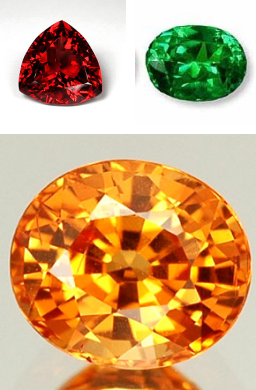
Garnets are one of the most popular stones found in a jewelry store. Garnets are usually affordable, durable, and aesthetically pleasing gemstones. The garnets that you will typically see are a deep red color, called “almandine.” These are the garnets traditionally used in birthstone jewelry. You also might see garnets of a pinkish-red tone, which are known as “Rhodolite” garnets.
At TQ Diamonds, we also carry two rarer varieties of garnets: Spessartite and Tsavorite. Spessartite garnets are a vivid medium-hue orange, reminiscent of a dazzling sunset. Tsavorite garnets are a deep, bright, sparkling green hue. One of our salespeople likes to say that Tsavorite garnets are “what emeralds aspire to be.”
Garnets’ roots have been traced all the way back to 3100 b.c. in the Egyptian Nile Delta. At the time, they were used for beads and inlay for Egyptian jewelry. The name “Garnet” comes from the ancient Greek word “Granatum,” because the deep red color reminded them of pomegranate seeds. Today, garnets of all shapes and sizes are found in a variety of African countries.
February - Amethyst
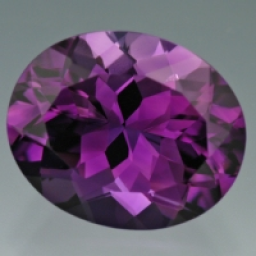
February’s birthstone is the ever-popular Amethyst. Amethyst is a purple gem whose hue can range from a pale lilac to a rich, dark purple. Its great variety of shades makes it an extremely popular choice for fashion jewelry lovers.
Amethyst has always been a much-loved gemstone. Throughout history, this gem has carried symbolic meaning for many religions and cultures across the world. The Catholic Church believed that it symbolized celibacy and piety. Tibetans felt that Amethyst was sacred to the Buddha. Greeks thought that Amethysts were an antidote to drunkenness (hence the name “Amethyst,” which comes from the Greek “Amethystos,” meaning “not drunken”). The Chinese philosophy of Feng Shui believes that Amethyst enhances your “wealth corner.” Even Leonardo Da Vinci thought that it was able to expel evil thoughts and quicken intelligence. Goblets, rosaries, and crown jewels have all been fashioned from Amethysts.
Amethyst is the purple variety of quartz. Mining of this gem is plentiful, as it can be
found in
March - Aquamarine, Bloodstone
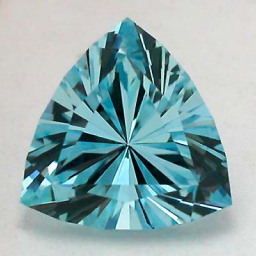
Aquamarine is a lovely blue gem, reminiscent of the sea. In fact, the name is derived from Latin terms, “Aqua” for water, and “Mare” for the sea. In ancient times, it was believed that Aquamarines were a gift from the god Neptune (the God of the Sea), and that these gems were good luck for sailors. Today, Aquamarines are associated with hope, youth, fidelity, and health.
Aquamarines come in
several shades of blue, from light to dark, all equally striking. These are also naturally very clean stones,
usually completely free of internal inclusions.
Aquamarines are generally affordable, with the exception of the larger
and more intensely blue stones, which can be very pricey. The best and most important Aquamarine mine
is in
Bloodstone
The alternate birthstone
for March is the much more masculine Bloodstone. Bloodstone is green jasper, sprinkled with
red iron oxide. This stone is also known
as Heliotrope, perhaps because the ancients felt that it looked like the sun
setting over the ocean. Ancient
Christians believed this to be a Martyr’s stone. They felt that the stone’s appearance
symbolized Christ’s blood falling on the jasper that was at the bottom of the
crucifix. The ancient’s would carve
bloodstone to reflect such biblical scenes.
Examples of carved Bloodstone can be found at the Louvre in
Bloodstone mining is done in
April - Diamond
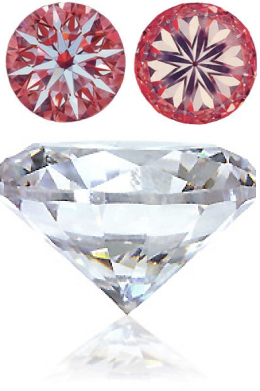
Most women born in April feel that they’re lucky to have a birthstone that they can wear with everything (though, parents buying birthstone jewelry for their children don’t always feel so lucky!). Diamonds are probably the most popular gemstone in any jewelry store, despite the expense. They are used in engagement rings, wedding bands, pendants, bracelets, earrings, watches, men’s fashion rings, and cufflinks, to name a few. Few things are as universally adored as the simple, sparkling beauty of a diamond.
Diamonds are the hardiest stones in the gem world. They have the highest rating on the Mohs Hardness Scale (a 10 out of 10), meaning that they can only be scratched by other diamonds, or metal materials that are as hard as diamonds. Diamonds that are unfit for decorative purposes are used in lasers, or as electric and thermal conductors.
As you might expect, diamonds have a long history throughout the world. Historians have traced diamonds in India back to at least 3000 B.C., if not 6000 B.C. The first evidence of diamond symbolism was found in Hindu devotional statues where diamonds were used as the eyes of the gods. The oldest dated book in the world is called “Diamond Sutra,” and is from 868 A.D. This book was found in a cave in northwestern China. Sutras are used to relay the teachings of the Buddha. Here, of course, “diamond” does not refer to the stone, but to 'diamond blade that will cut through worldly illusion to illuminate what is real and everlasting'. As you can see, diamonds have always left an impression on human beings.
Today, nearly half of the world’s diamonds are mined throughout Africa. However, there are other viable mining deposits in Russia, Australia, Canada, and Brazil.
May - Emerald
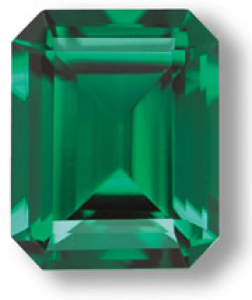
The May birthstone is the highly coveted Emerald. Emeralds vary from light to dark green hues, each beautiful in their own way. What stands out about this gem is that even expensive emeralds are allowed to have eye-visible internal inclusions. Emeralds are formed under such heat and pressure, that the majority of them turn out with inclusions. Because color matters most, the more vivid the shade of the green, the more highly prized the Emerald. Of course, an eye-clean and vividly green Emerald would command a very high price. In fact, carat for carat, very fine Emeralds can be twice as expensive as diamonds.
Emeralds have held the fascination of many cultures for over 6000 years. Emeralds were worshipped by the Incas and mentioned in Biblical verses concerning the apocalypse. Aristotle often touted these gems as being able to increase the owner’s importance in presence and speech during business, as well as give victory in trials, help to settle litigation, comfort and soothe eyesight, and prevent epilepsy. Egyptians believed they stood for fertility and rebirth. Many cultures considered them “good luck charms.”
Though quite beautiful, these gems are very soft and fragile. People who are hard on their jewelry may want to consider Emerald earrings or a pendant instead of a ring. Any way that you wear them, though, they are certain to make a striking addition to your jewelry wardrobe.
Today, most emeralds are mined in
June - Alexandrite, Pearl, Moonstone

Alexandrite is what’s known as a “phenomenal” gemstone. This means that the gem displays certain optical characteristics that allow it to have two different colors. Alexandrite is green in natural daylight, but is reddish-purple in artificial light!
This rare and beautiful stone was discovered in 1830 in Russia, and was named after Czar Alexander II as a birthday gift for the young boy. Russian mines in the Ural Mountains ran out of Alexandrite after twenty years of production. Since then, Alexandrite has been found in Sri Lanka, Zimbabwe, Brazil, and India. Each mine produces Alexandrite of slightly varying colors and intensities.
Even with a few mines producing Alexandrite, this is an extremely rare stone in the gem world. Due to the rarity and expense of natural Alexandrite, most June birthstone jewelry is made from synthetic materials. Many jewelry stores do not carry natural Alexandrite items in stock, because there is a very small demand for such a difficult-to-find and costly stone.
Pearls
Pearls are an alternate birthstone for June. Ever since the Han Dynasty in
Pearls come in many shapes, sizes and colors—too many to count, in fact! Natural pearls are grown within the soft tissue in the mantle of a mollusk (specifically clams, mussels, and oysters). A pearl starts to form when a bit of sand or other small particle is lodged inside of the mollusk. The foreign object acts as an irritant, so the mollusk secretes a hard substance called nacre to smooth it over. This secretion happens many times and eventually forms a pearl. Natural pearls are generally perceived as accidents, and therefore, are quite rare (and expensive). Therefore, the majority of pearls sold in today’s market are called “Cultured” pearls. These pearls are still grown in mollusks, but they are given a helping hand by humans. Because of cultivation for all types of pearls, there is certainly no shortage of pearls in the marketplace!
Moonstone
Moonstone is yet another
birthstone option for June. These
iridescent, shimmering silver-blue stones are absolutely mesmerizing. Moonstones are from the feldspar family of minerals, which constitute two-thirds of the
rocks present on earth. Uncut, you would
never guess the potential beauty that lies within!
The moonstone is said to symbolize our being in its
entirety. They also stand for the true
joys of love, intuition, capacity for understanding, dreams, and
fertility. Some cultures view this as a
holy, magical stone.
Traditionally, the Moonstone is found in
July - Ruby
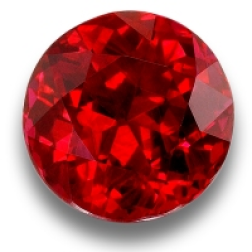
No other stone is associated with royalty quite like the Ruby. In Sanskrit, Rubies are called “Ratnaraj” which means “King of Gemstones.” They are revered in the Bible and in Sanskrit writings as being the most precious of all the gemstones. In ancient India, whenever an exceptional Ruby was uncovered, the Emperor would send out court members to meet the ruby and welcome it into their community.
It is not difficult to see why Rubies have always been a
highly decorated gemstone. Rubies are
one of the toughest stones on the Mohs hardness scale, so they are very
durable. At the same time, they are
exceptionally brilliant and colorful stones.
The deep red of Rubies conjures up images of heat, passion, and love. The powerful feelings that Rubies evoke make
them a wonderful and meaningful gift.
The most important aspect of a Ruby is the color. Moderate amounts of inclusions do not affect
the price of a Ruby so much as the color will.
High quality Rubies are difficult to find; but large, high quality gems are quite rare and very expensive. Smaller sizes of Rubies can still be pricey
depending on the quality, but are not generally unaffordable.
Rubies come from all over the world. Mines are found in
August - Peridot, Sardonyx
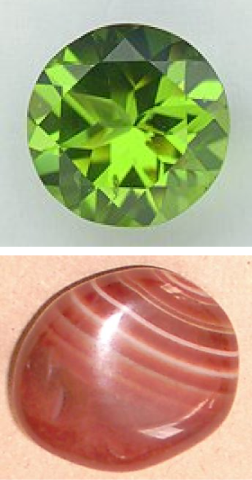
Peridot is the only gemstone born from fire! These gems originated from volcanic eruptions
on an island in the Red Sea. They have been found in other volcano’s rocks
around the world since then. There have
even been Peridots mined from a meteor that fell in
Due to their association with volcanoes, Hawaiian folklore says that Peridots are the tears of Pele, goddess of the volcano. Peridots have been associated with magical powers throughout history, such as the power to ward off evil spirits and to protect against nightmares. As with many gemstones, Peridots have been frequently utilized in church ceremonies and rituals.
The ancient Romans called Peridots the “Evening Emerald.” This was because you could see the sparkling light green color, even in dimly lit rooms. Peridots range in color from a light yellow-green to a rich, medium apple-green. They are quite affordable, particularly in smaller sizes. This makes them a very popular choice for fashion jewelry. Today, most Peridot is mined in Arizona, Myanmar, China, Sri Lanka, and Pakistan.
Sardonyx
Sardonyx is the alternate birthstone for August. This is the red variant of the stone Onyx, which is black. This stone is an opaque, reddish-brown, and is typically banded with irregular white markings. Sardonyx is usually found in men’s fashion rings, but would be beautifully used in women’s pendants, rings, and earrings, as well.
Sardonyx was very highly prized by the ancient Greeks and Romans. They believed that it would bring the wearer courage and victory. Since Sardonyx is a soft stone, images of Hercules and other brave warriors would be carved into Sardonyx cameos and carried into battle by soldiers. Today, Sardonyx is still used for carving cameos. Sardonyx has also has been associated with harmonious relationships. As an old saying goes, “The August maiden, with sweet simplicity, wears Sardonyx, gem of felicity.”
September - Sapphire
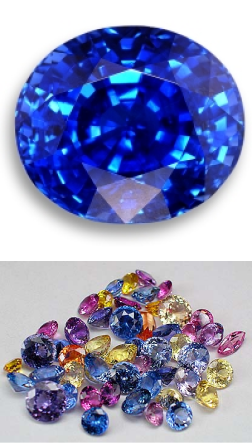
Once upon a time, people believed that the sky was an enormous sapphire into which the world was embedded. Though we know that isn’t true, sapphires have continued to hold the fascination and admiration of all for thousands of years. Sapphires have always been prized for their beautiful blue color, hardness (second only to diamonds on the Mohs hardness scale), and transparency. It wasn’t until 200 years ago that Sapphires were classified as corundum family of minerals. Prior to this, only blue Sapphires were called as such. Now we know that Sapphires come in every color of the rainbow, except for the deep red sapphires, which are called Rubies. Any non-blue Sapphire is known as a “fancy” Sapphire.
Sapphires are valued depending on size, color, and transparency. Pure, strong blues command the highest price, followed by royal blues, and deep cornflower blues. Sapphires with exceptional color carry corresponding price tags, particularly if they’re large. Very dark blue or blue-black sapphires are much more common and inexpensive. As with all things, though, different shades are valued by different people, regardless of rarity or expense. The great thing about Sapphires is that each gem is as individual as the person who wears them.
Sapphires are mind in
October - Opal, Tourmaline
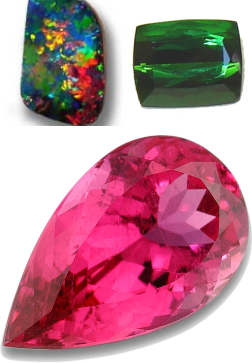
Opals are truly a gem that has been adored, worldwide, for thousands of years. Archaeologist Louis Leakey found 6000 year old opal artifacts in a cave in
Since Opals are mined from rocks, they come in a variety of shapes with a huge range of color play. The most common type of Opal is a translucent, milky white color with a minimal spray of rainbow colors. Opals also come in a “black” variety, where the background is black or dark gray, with much more vivid splashes of rainbow colors. This makes for a very dramatic Opal. The third type of Opal is called a Boulder Opal. Boulder Opals are mined from Ironstone Boulders in
Most Opals are mined in
Tourmaline
November - Topaz, Citrine
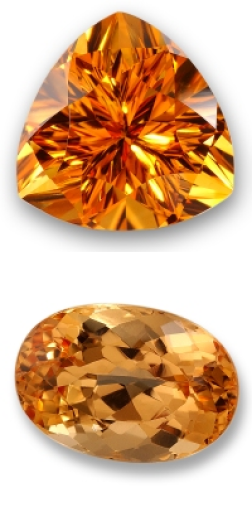
As it is traditionally known, Topaz is a brown or yellow-brown gemstone. Much of what you will see in jewelry stores today is Blue Topaz, which can range in color from light to dark blue. Since Blue Topaz is an alternate birthstone for December, please visit that page for more information about that particular stone.
The ancient Egyptians said that Topaz was colored with the
warm glow of the sun god, Ra. Since Ra was very important to the Egyptians,
this naturally made Topaz a very important and protective amulet for those who
were faithful to him. Even the Romans
associated Topaz with Jupiter, the god of the sun. Ancient Greeks thought that Topaz could make
wearers invisible. It has been said to
cure ailments from asthma to insomnia, and was alleged to alert the wearer to
poisoned food.
Most Topaz is not expensive or particularly difficult to
find. Imperial Topaz, which possesses a
beautiful, rich honey color, can be much more expensive and is far rarer in
larger sizes. Topaz is mined in
Citrine
The alternate birthstone
for November is Citrine. Citrine is a
bright gemstone, usually of a juicy golden color (the name derives from the
French word for lemon, “citron”). The
color can also be very yellow or darker with orange undertones. The darker version of Citrine is named “
Citrine was once thought to protect the wearer from evil
thoughts, as well as snake venom. This
durable stone is mined mostly in
December- Blue Zircon, Tanzanite, Blue Topaz, Turquoise

Don't be fooled-Zircon is not the same as Cubic Zirconia. Zircon is a natural stone, which only adds to its spectacular beauty. Zircon comes in many shades, from clear to brown, to the most popular version, blue. Most Blue Zircon has a pale-to-medium hue, but you can find some vivid, bright blue gems. The very bright Blue Zircons are the most expensive, and are far more difficult to find in stores. No matter what shade you choose, one thing is certain: Zircon is one of the only stones that sparkles like a diamond.
During the Middle Ages, Zircon was thought to protect the traveling wearer from harm. It was thought to promote restful sleep, honor, wisdom, prosperity, and spiritual growth. Even today, some Hindus believe that Zircon can aid in spiritual growth.
Today, Zircon is mined in Cambodia, Sri Lanka, Thailand, Myanmar, and Australia. Zircon is a heavier gemstone than most others. Despite its density, it can scratch very easily, so treat it with care!
Tanzanite
Unlike all of the other stones featured on our website, Tanzanite does not have much history. Tanzanite was only discovered in 1967, in its namesake of Tanzania. Upon its discovery, it was brought to market by Tiffany & Co. Originally, the stone was named "Blue Zoisite." Louis Tiffany, however, was reminded of the word "Suicide," and changed the name to "Tanzanite." It has been a hit ever since.
Tanzania is the only place in the world where Tanzanite can be found. Obviously, this makes it an extremely rare and often very expensive stone. Gem lovers are taken by Tanzanite's deep blue-purple hue. The most rare and expensive Tanzanite has prominent flashes of red, as well. Most Tanzanite that you will see in the marketplace is a light to medium lilac color. Lighter Tanzanite is not exactly inexpensive, but is much more affordable than the rare type. No matter what shade you wear, bold and beautiful Tanzanite expresses each individual's unique qualities.
Blue Topaz
Blue Topaz, an alternate December birthstone, is a very popular gemstone in jewelry stores. It is very inexpensive, even if the stone is large. The color is so vibrant that it attracts many people. The shades of blue vary from a pale "Sky Blue" (like an Aquamarine), to a bright, medium "Swiss Blue," to a dark, smoky "London Blue." All shades are equally lovely-which one you choose is entirely up to your individual taste.
Blue Topaz is enhanced by heat treatment. Stones that are now blue were originally clear, but were treated by humans to become that way. There is nothing that could be done to remove the coloring, however, so no special care is needed.
Blue Topaz is mined in Brazil, Sri Lanka, Nigeria and China.
Turquoise
Turquoise is a beautiful copper-rich stone of varying shades of blue, occasionally interspersed with black lines. The color can vary from sky blue to green, but all shades seem to be popular. Since Turquoise looks good on all skin tones, it has been popular for many years in various forms (including beads, rings, bolo ties, and belt buckles).
Turquoise has a rich history. It adorned rulers of ancient Egypt, Mesopotamia, Persia, China, and the Aztecs. Its most well-known historical use was to decorate King Tut's burial mask and tomb. It was first introduced to Europe through Turkey, where we believe it got the name "Turquoise," which sounds like French of "Turkey." Turkey does not produce Turquoise, it was just a trading thoroughfare. Wearers of Turquoise were thought to be protected against unnatural death. It was also thought to promote well-being and affluence.
Turquoise is very soft, so should be treated carefully. It should be wiped clean with a soft cloth to remove dirt and dust. Additionally, it should be protected from bright sunlight to prevent color fading. Turquoise is a very affordable stone, which has added to its appeal in fashion jewelry. It is mined widely in the United States, Mexico, Israel, Iran, Afghanistan and China.